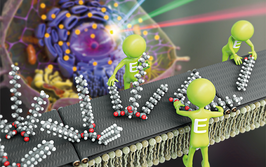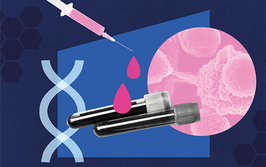
The “cellular kill code” that small interfering RNA (siRNA) molecules harness to eradicate cancer cells has been present for an estimated 800 million years. Unfortunately, we haven’t known what it is or how to use it – until now. The deadly code has now been found to result from just six nucleotides – between positions two and seven in a sequence of 19 – known as the 6mer seed sequence. Marcus Peter, Professor of Cancer Metabolism at Northwestern Medicine, Chicago, USA, led research into the siRNA nucleotide sequence. And he is now understandably excited by the prospect of targeting cancer.
“Once we knew that it was just six nucleotides responsible for the toxicity, and that there are only four possible nucleotides for each of these positions, it became clear that we could screen all 4096 possible 6mer combinations to identify the deadliest kill code,” Peter says. The researchers found that the most toxic composition to cancer cells consisted of guanine enrichment toward the 5ʹ end, terming the sequence “G-rich.”
Peter continues, “We believe the G-rich 6mer is not only toxic to cancer cells, but all cells of the body, regardless of their tissue of origin. Our data suggest that healthy cells are protected from the mechanism by an extremely high expression of microRNAs (miRNAs) that carry non-toxic 6mer seeds. When cells become cancerous, they downregulate these non-toxic miRNAs, rendering them susceptible to the 6mer seed’s toxic mechanism.” Analyses suggest that mature miRNAs have evolved over time to avoid guanine at the 5ʹ end of the 6mer sequence, preventing the killing of healthy cells – but some naturally occurring tumor-suppressive miRNAs have taken the opposite tack, preserving a G-rich 6mer seed that can eradicate cancer cells.
Cancer cells were unable to develop resistance to the toxic mechanism both in vitro and in vivo, making it a highly effective kill code. “Based on these findings, we can now design artificial miRNAs to make their toxicity as high as possible, even to the point where they are more toxic than the ones designed by nature,” says Peter. But despite their “micro” size, drug delivery will represent a challenge: “These RNAs are actually quite large compared with small molecule drugs. To have a real impact, we need to find ways to get them into every single cancer cell. We are working on a number of ways to achieve this; we are seeking industry partners that can help us take our concept to the next level.”
- W Putzbach et al., “CD95/Fas ligand mRNA is toxic to cells”, Elife, [Epub ahead of print] (2018). PMID: 30324908.
- QQ Gao et al., “6mer seed toxicity in tumor suppressive microRNAs”, Nat Commun, [Epub ahead of print] (2018). PMID: 30374110.
While completing my undergraduate degree in Biology, I soon discovered that my passion and strength was for writing about science rather than working in the lab. My master’s degree in Science Communication allowed me to develop my science writing skills and I was lucky enough to come to Texere Publishing straight from University. Here I am given the opportunity to write about cutting edge research and engage with leading scientists, while also being part of a fantastic team!




















